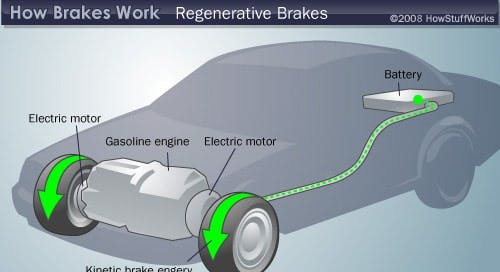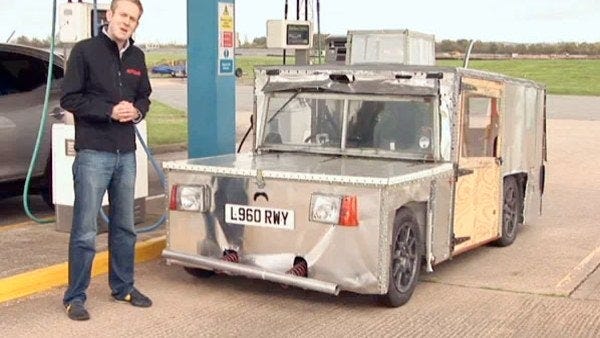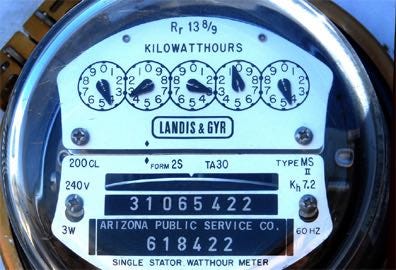Dear Readers,
There are a lot of people interested in Electric Vehicle charging and driving costs. I’ve don't a few EV towing tests, and talked to several engineers at the Detroit Auto Show last year. So I’ve been learning a lot about the EV charging infrastructure lately.
Here’s a few questions and comments I’ve heard from my readers recently. With all the marketing hype and misinformation floating around I’ll try to provide some clear answers.
Can generators in the EV wheels recharge the batteries while driving?
Q: “These EV vehicles should have come with self-charging devices like others have on the braking and running of the wheels. Just think of the times all four wheels rotate and have a small alternator-type recharging system on each. Then you have no worries of running out of power.”
A: Actually, all EVs have motor/generators in the wheels, and this is what allows for regenerative braking when slowing to a stop or going down a grade. This technology does a great job of recovering perhaps 80% of the kinetic energy that otherwise would end up as heat in the brake pads or shoes. But TANSTAAFL (There Ain’t No Such Thing As A Free Lunch). So having electric motors in two wheels and generators in the other two wheels will never make extra power. This is essentially like plugging your inverter into your battery charger and expecting to create extra energy.
What about putting a free energy generator in my EV?
And the above question is essentially about a “free energy” generator that doesn’t exist. When I was 8 years old, I designed and built a free energy generator which consisted of an electric motor connected to a generator with pulleys that would then feed the generator output back into the electric motor.
I thought it would generate enough electricity to power my house and actually tied it into the fuse panel. But, of course it didn’t, and all I did was blow a bunch of fuses. Free energy generators didn’t work 60 years ago, and they don’t work now. And any videos you watch claiming to be free energy generators are just clickbait.
Why a gas generator in back of the EV won’t work
Q: “Hi, Mike. Everything is dependent on batteries these days. I think strip out the batteries altogether and go more direct. Run the EV or whatever electric vehicle it is with just a generator. It can’t be that hard and it would be cheaper than having to keep charging it up, and hanging around waiting and see how that works out.”
A: What makes an EV so much cheaper to drive is that electric motors are much more efficient than a gasoline engine. So the 75 to 100 kWH of batteries allows you to store energy that was cheaper to produce to begin with. Gasoline and diesel fuels take a lot of processing and transportation costs by the time they arrive at the pump. And then your vehicle is still only 30% efficient at turning that stored energy into driving it.
So putting a portable generator in the back of your EV in place of the batteries is the worst of all worlds. You now have a very inefficient generator without any emission controls powering highly efficient electric motors. Once the energy is lost, it’s lost.
Can this work at all?
This does indeed work for is a diesel-electric locomotive, where diesel engines with thousands of horsepower drive huge generators, which then power the traction motors/generators in the wheels.
But this really acts like an infinitely variable transmission that can transfer exactly the needed power to each wheel on the locomotive. And it also acts like an exhaust brake by feeding the wheel generator output while going down a big grade into huge resistor panels in the roof the locomotive engine. There’s no battery storage in a locomotive simply due to scale and cost.
The new Ramcharger 1500 pickup truck is different
The 2025 RAM 1500 Ramcharger is a Plug-In Hybrid truck with a 145 mile battery range and a 3.6L V6 gasoline engine that can continuously recharge the battery while driving or parked. Of course, you never have to use the gasoline engine at all if you drive less than 145 miles per day.
It has an all-electric drivetrain with a big gasoline generator feeding 4-wheel drive electric motors with a 600+ mile range. But how much range is lost while towing an RV. That’s what I propose to find out.
Watch my video podcast with Tony Barthel HERE.
All-new 2025 Ram 1500 Ramcharger’s battery electric vehicle technology delivers the industry’s best combination of range, towing and payload
New level of performance delivered with 250-kilowatt (kW) front and 238 kW rear electric drive modules (EDMs) powered by an on-board 130 kW generator and a 92 kilowatt-hour (kWh) battery with a targeted range of up to 145 miles on battery alone and 690 miles combined gasoline and battery
All-new 2025 Ram 1500 Ramcharger is capable of:
663 horsepower and 615 lb.-ft. of torque
0 – 60 miles per hour (mph) in 4.4 seconds
Towing up to 14,000 lbs. and payload of up to 2,625 pounds
So are EVs cheaper to run than an internal combustion engine (ICE) vehicle?
As I’ve written before, your mileage will vary (literally) depending on the local cost of electricity. If you pay 14 cents per kWh at your house, like I do, then an EV can cost less than 1/3 of what a gasoline engine needs at the pump. And many states are offering 50% discounted electric power if you charge your EV batteries between 9pm and 9am. I could be paying 8 cents per kWh in Maryland if I added a smart meter for Class-2 EV charging.
But some states like California can cost in excess of 40 cents per kWh, so it may not be much of a savings compared to gas or diesel, unless you put enough solar panels on the roof of your garage to charge your EV.
What about internal combustion engine (ICE) maintenance costs?
And don’t forget about all the additional costs for ICE vehicles of regular oil changes, transmission and differential fluid, antifreeze flush and other ICE maintenance items not in an EV. I just got a $1,129.70 quote for my wife’s Kia Sorento for its 30,000-mile recommended maintenance schedule covering those above items (not including the oil change, which was on top of that). Here are some of the things they want me to pay for at the next service interval. Yikes!
Yes, the batteries in an EV will be expensive to replace, but many of the EV manufacturers are offering 100,000 mile battery warranties. And the brakes in an electric vehicle will last a lot longer since much of that kinetic energy can be used to recharge the batteries rather than heating up your brake. And that heat from your friction brakes is lost energy.
So are EVs a clear winner yet?
Not yet, because there’s still a lot of challenges to be overcome such as enough charging stations, renewable energy production and material availability (such as lithium for the batteries). But clearly the manufacturer push is in that direction.
However, I firmly believe that the American engineers, scientists and entrepreneurs who invented 3-phase power, mass production of automobiles and the internet are up to the challenge. I just don’t know when. But I’m watching this closely, as so many of you apparently are, and I will keep you updated.
Let’s play safe out there… Mike













Mike, your KIA service pricing is for
BG services and fluids! That makes a big price differential
There is hope for older hybrid vehicles in that lithium iron phosphate battery upgrades and repair at the individual cell level are now available! Repairing or upgrading the battery on an old hybrid before selling it (or keeping it) should mire than offset the decline in value mentioned above. Individual cell repair is also available which means that replacing the entire battery is not always necessary. Hybrid owners should know about the easy maintenance trick of cleaning the air filter for the hybrid battery cooling fan. Doing this regularly should really help prolong the life of a hybrid battery. Or, one could buy an otherwise good hybrid with a bad battery for a good price and replace the battery.
https://www.theautopian.com/toyota-prius-owners-are-swapping-tired-old-batteries-for-lithium-ion-ones-and-seeing-big-gains/